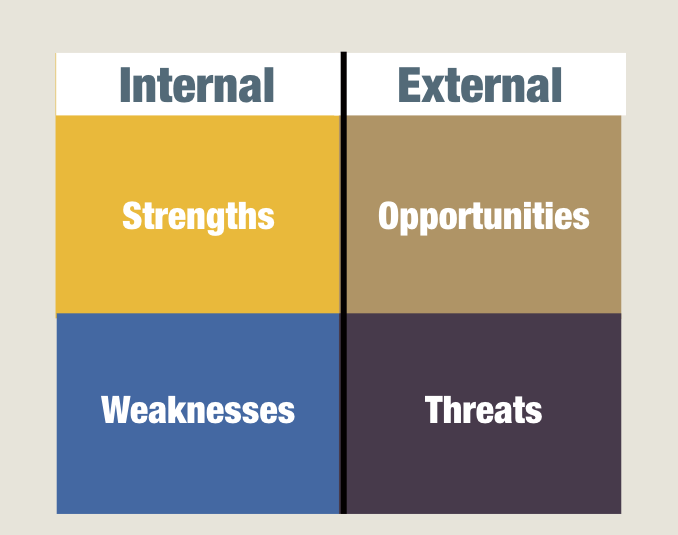
There are so many options when it comes to assessing the performance of your business that it can be hard to know which to choose. SWOT analysis is a popular tool that helps you to assess the strengths and weaknesses of your organisation, and identify the threats and opportunities that could affect your future.

Read on to find out how a SWOT analysis could help your business grow.
Why SWOT analysis is so powerful
SWOT analysis is so helpful as it combines both internal and external factors to paint a completely clear picture of where your business currently stands, and where it’s likely to be in the future.

Other techniques might be great at helping you assess your own organisation, but could ignore serious threats from competitors. An analysis that’s too insular could also miss key opportunities for growth and development outside the business.
On the other hand, focusing solely on external factors means you’re reliant upon the actions of others, which takes control out of your hands and limits opportunities for internal improvement.
Carrying out a SWOT analysis ensures you get the right balance of internal and external factors.
When should I use a SWOT analysis
A SWOT analysis can be helpful in many areas of your business, and we’ve listed some suggestions below:
• When setting new business objectives
• To analyse existing strategies
• When planning projects
• When monitoring project/strategy success
• When planning your marketing strategy
There are no strict rules about where and when to use a SWOT analysis. As a general rule, they’re useful anytime you’d like to assess your current strengths and weaknesses and look for opportunities for growth.
How to do a SWOT analysis
Wondering exactly what a SWOT analysis looks like? Here are some key questions you should ask for each section.
Strengths
• What’s your unique selling point?
• What do you do better than any of your competitors?
• Which aspects of your organisation are particularly strong?
• Which factors make customers choose you over similar businesses?
• Which product or service makes you stand out from the crowd?
Weaknesses
• Where is there room for improvement within your business?
• Which factors cause you to miss out on sales?
• Which area of your business has consistently encountered problems?
• What about your business are customers likely to perceive as weakness?
Opportunities
• Are there any current trends you could take advantage of?
• What changes in your market could provide opportunities for growth?
• How can you take advantage of changes in policy?
• Are there any local events you could become involved with?
Threats
• What are your competitors doing? Is this a threat to your business?
• Could changes in your market negatively affect your business?
• Do you have any quality issues?
• Do you have any issues with cash-flow or debt?
• How seriously could these threats affect your business?
Still not exactly sure what your SWOT analysis should look like? Check out the full examples below for inspiration.
Example SWOT analysis 1
You run a fast food shop that’s been experiencing a drop in sales, and conduct a SWOT analysis to find out why. Here are the results.
Strengths
• Cheaper food than any nearby shop.
Weaknesses
• High staff turnover – many staff are not fully qualified.
• Scored very poorly on several recent health inspections.
• Food quality much lower than nearby shops.
Opportunities
• New nightclubs are opening in the surrounding area, which will increase the number of customers late at night.
• A local competition for best fast food shop is taking place soon.
Threats
• The increase in online review sites means that people can read negative reviews of the shop when deciding whether or not to visit.
• A new chain fast food shop is opening down the street.
In this analysis, we can see that the weaknesses of the fast food shop outweigh the strengths – this is a key warning sign. Looking for ways to remedy the current weaknesses, and taking advantage of the listed opportunities should help this business to grow.
Example SWOT analysis 2
You run a small toy shop on a busy high street. You’d like to increase the growth of your business and decide to carry out a SWOT analysis. Check out the results below.
Strengths
• More unique toys than nearby shops.
• Very friendly and personalized service, excellent staff.
Weaknesses
• More expensive toys than competitors.
• Brand not as well established as big chain toy shops.
Opportunities
• Local children’s hospital is holding a big event to encourage toy donations. Sponsoring the event and donating toys could improve the company’s brand image and lead to positive publicity in local media.
• A certain brand of toy is trending on social media. Focusing marketing efforts on this toy will encourage customers to visit.
Threats
• A large chain toy store is opening across the street and could threaten sales.
• Video games are becoming more popular than traditional toys.
In this analysis, we can see that the business has some key strengths and opportunities that can be of use when deciding how to deal with threats. Focusing on providing great service and building a good local image could help our small, independent toy shop deal with the threat of chain toy shop opening across the street.
If you want to get a clearer idea of how your business can grow and improve, carrying out a detailed SWOT analysis is a great place to start.
The post How SWOT Analysis Can Help Your Business Grow a Lot appeared first on Lifehack.

from Lifehack http://ift.tt/2nVk3Al